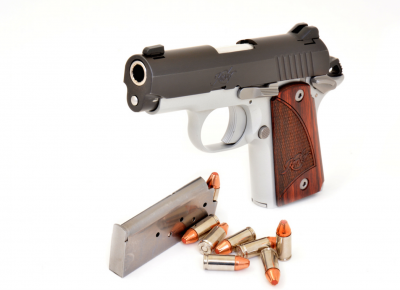
Barely 10 percent larger than a Colt Mustang .380 ACP, the new 6+1 capacity Kimber Micro 9 measures 6.1 inches in overall length, 4.07 inches in height and weighs 15.6 ounces.
Can you make a single stack, 6+1 capacity subcompact 9mm semi-auto that is practically no larger than most .380 pistols? The answer is yes, if you’re Kimber and you start with an interesting premise, that the original Colt Mustang .380 ACP was nearly big enough to handle a 9mm round. That’s quite a leap of faith for what was, at the time, the smallest .380 semi-auto ever designed. The time was 1986, and the Colt Mustang was the most significant breakthrough in .380 ACP pistol designs since the Walther PPK in 1930.
The Mustang was introduced by Colt’s 30 years ago. The current Mustang Pocketlite version looks and feels a little different from the original with a superior fit and finish. With a loaded magazine the current Mustang Pocketlite tips the scales at less than a pound, and measures 5.5 inches in length with a 2.75-inch barrel. With a 6+1 capacity “cocked and locked” is the standard carry method, just like a Model 1911. One unique feature of the Mustang (now copied by other manufacturers of the Mustang design), is a thumb safety that permits the slide to be manually cycled, even when the safety is set, thus one can check for a loaded chamber, clear the gun or load the first round with the safety still engaged.
This same description also fits the new Kimber Micro 9, although the Kimber has an even better level of fit and finish, and of course, the one big difference, it is a 9mm not a .380. But look at those specs, the Mustang’s overall length is 5.5 inches; it has a 2.75-inch barrel, and weighs less than a pound in carry weight. The Kimber Micro 9 is just one half inch longer at 6.1-inches in overall length, and that includes an upswept extended beavertail, which is better than the Mustang’s shorter down turned beavertail.
Article continued below:
With both semi-autos very close in overall length, the Mustang .380 has a 2.75-inch barrel and 4.75 inch slide length, while the Kimber’s barrel is 3.15 inches in length with a 5.25 inch slide length. And as for carry weight, the 6+1 capacity Micro 9 is 15.6 ounces, just under a pound like the Colt Mustang. The thumb safety design is the same type as the Colt’s, allowing the Micro 9 to be carried cocked and locked, yet the slide can still be racked with the safety engaged. Kimber has succeeded in building a 9mm that is the almost the same size as a .380 once regarded as the smallest on the market.
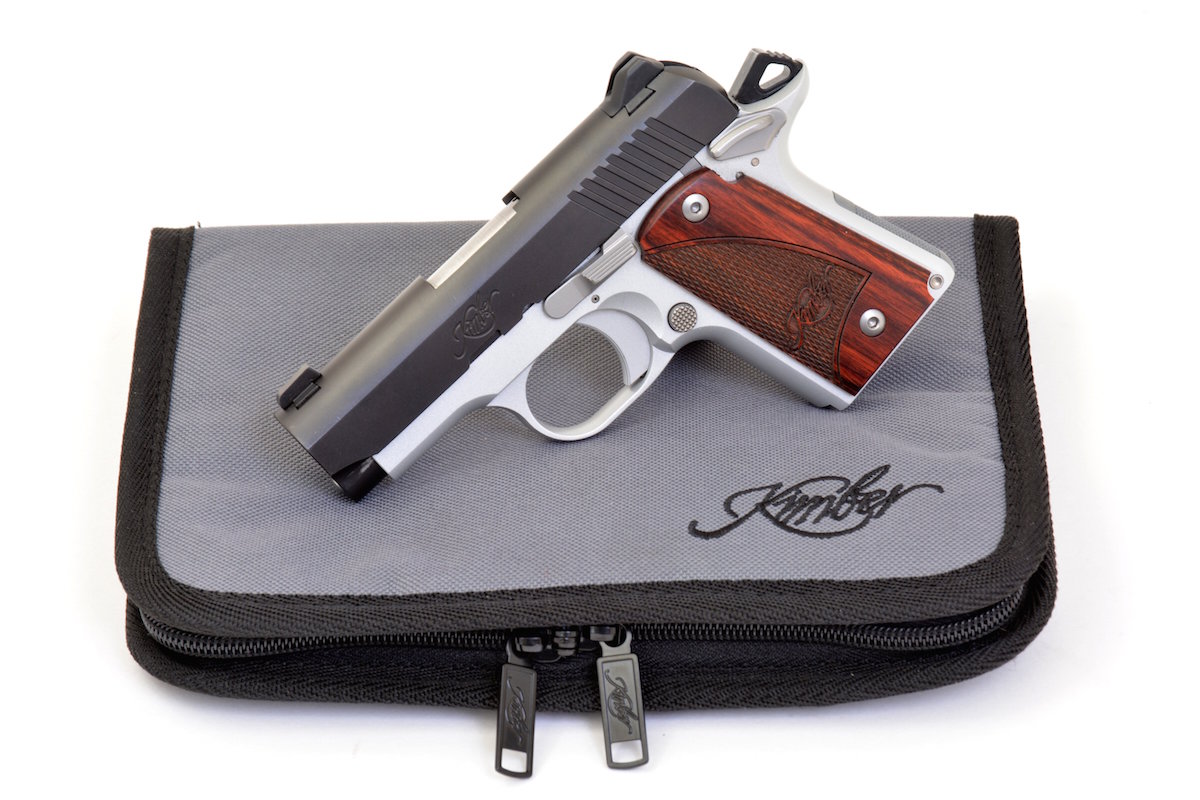
The Kimber Micro 9 is easily one of the smallest 6+1 capacity 9mm semi-autos on the market. Just 0.6 inches greater in length then a Colt Mustang, Sig Sauer P238 or Kimber’s own Micro CDP .380, the new Micro 9 model is the best handling 9mm pocket model ever.
Pocket Pistol Evolution
Semi-auto pocket pistols had their origins with John M. Browning before the turn of the last century (around 1897), but they were chambered in smaller calibers, .25 ACP and .32 ACP. It wasn’t until 1908, when Browning designed the .380 ACP and the gun to fire it, the Colt Model 1908 Hammerless, that a significant improvement in pocket pistol stopping power was achieved.
The Colt Model 1908 Hammerless was based on Browning’s .32 ACP Colt Model 1903 Hammerless and both remained in production until 1940 and 1942, respectively. This was the American standard for a medium caliber pocket pistol and while neither the cartridge nor the pistols to fire them were unique to America, Colt owned the semi-auto pocket pistol market in the early 20th century.
The evolution of the semi-auto pocket pistol in America was resurrected by Colt’s with the introduction of the Mustang .380 in 1986. There were, of course, other .380s on the market, including the most famous .380s of all, the Walther PPK and PPK/S, but for the American market of the 1980s, the Colt Mustang was a milestone. All that it lacked in the minds of most Americans and law enforcement officers was sufficient stopping power. Since its inception, the .380 ACP FMJ round had remained a far cry from the ballistic performance of a 9mm, or even a .38 Special. But, while the .380 was once an underpowered round, it is not so today. The one thing possibly overlooked until the past few years was that the same performance improvements that have been applied to the .380 ACP cartridge have also been applied to the 9mm; one reason why it is once again being considered as the standard caliber for law enforcement.
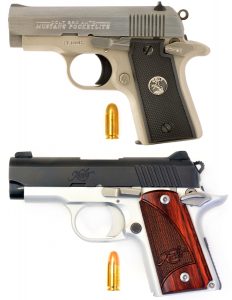
Hard to believe, but the Kimber Micro 9 (bottom) is a mere 10 percent larger overall than a Colt Mustang Pocketlite .380 (above), has the same operating features, and packs 6+1 rounds of 9mm.
Specs
- Chambering: 9mm
- Barrel: 3.15 inches
- OA Length: 6.1 inches
- Weight: 15.6 ounces (empty)
- Grips: Rosewood
- Sights: Dovetailed black combat style
- Action: Single-action
- Finish: Matte-black
- Capacity: 6+1
- MSRP: $654
Building A “Little Big Gun”
Breaking down the barriers between size and caliber has been Kimber’s forte for years. Established in 1997, Kimber became world renowned for building 1911s of unexcelled quality and standardized custom features. But the real heart of Kimber’s ingenuity was revealed when the company introduced the groundbreaking 9mm Solo Micro Compact in 2011. At that point in time the Solo was the smallest single stack 6+1 capacity 9mm pistol in the world.
Kimber then turned its sights on the .380 concept with the Micro CDP and an entire Micro .380 line. Looking like a highly refined Colt Mustang (exactly what it is, just like the Sig Sauer P238 Series) with a standard capacity of 6 +1 the .380 ACP Micro series left Kimber with one remaining challenge and in 2016 Kimber took the next logical step by introducing a slightly larger Micro variation chambered in 9mm.
Micro 9
The Micro 9 slide is made to the same tolerances as the Solo, Micro CDP and other Micro versions. The alloy frame has a distinctive matte silver finish and very smooth lines. The grip is shaped for strength and a solid hold using an upswept beavertail and deeply checkered mainspring housing that rests in the palm swell. In many respects, the Micro 9, like the Colt Mustang, Kimber Micro CDP and Sig Sauer P238, is a scaled down 1911 without the grip safety, thus it is a very familiar gun to handle.
Ease of handling also comes down to the trigger design on a pocket pistol, and here again Kimber scores with a smooth solid aluminum match grade single action trigger that has a short, smooth pull averaging 6 pounds, 2.5 ounces with a mere 0.188 inches of travel, no stacking, a very crisp break, and a short 0.125 inch reset. The thumb safety, slide release and magazine release are pure Colt Mustang inspired, though the Micro 9 thumb safety has the same improved contour as the Micro CDP .380.
Where the Kimber design really kicks in, aside from the fit and finish, are standard features which include a highly polished stainless steel barrel, lowered and flared ejection port for superior ejection of spent shells, a beveled magazine well for quick reloading, and dovetailed combat-style front and rear sights. These are steel sights mounted in machined dovetails so they can be upgraded to white dot or tritium night sights. The gun comes with one flush-fitting 6-round magazine and Kimber offers an extended capacity 7-round magazine.
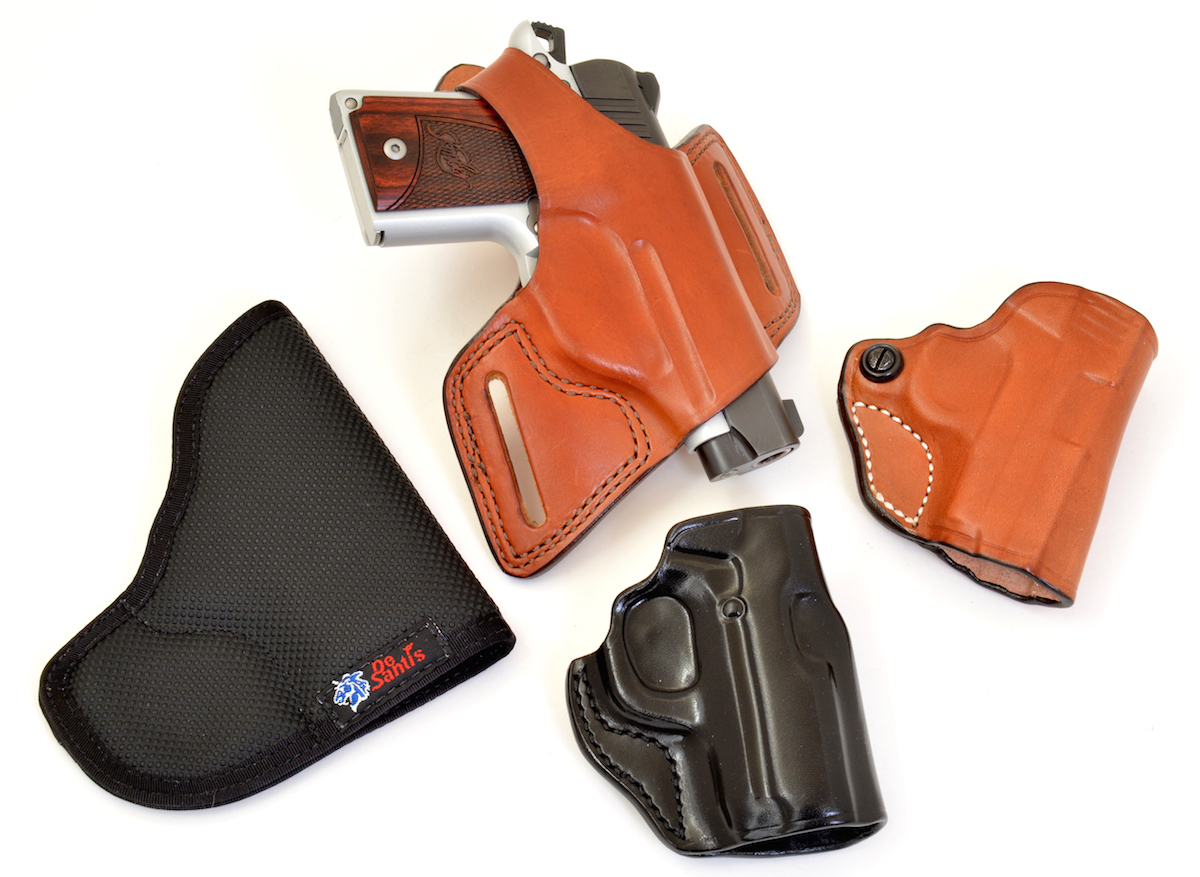
If the shoe fits, wear it. The Kimber Micro 9 perfectly fits all of these holsters designed for .380 Autos; the DeSantis Nemesis pocket holster (left), Safariland Bianchi Black Widow thumb break belt rig designed for the Walther PPK/S, (top center), DeSantis Mini Scabbard for the Sig Sauer P238 (right) and Galco Stinger (bottom) for the Walther PPK/S.
Hands On
Ideally, Pocket Pistols are intended to be carried in pockets. To that end the Kimber Micro 9 fits into the majority of pocket holsters designed for the Colt Mustang, Kimber Micro CDP, Micro .380, and Sig Sauer P238 models, even though the Micro 9 is about 0.5 inches longer. As for belt holsters, the Micro 9, for whatever reason, fits very nicely into the same holsters at the Sig Sauer P238 with a little muzzle exposed, but otherwise a sold fit. The most interesting holsters I had on hand that were perfect for the new Kimber was a contoured Galco Stinger open top belt rig made for, of all things, a Walther PPK/S and a Safariland Bianchi Black Widow thumb break for the PPK/S, that also fits the Micro 9 like a glove. If you are shopping around for a Micro 9 holster, there are already a number available including 20 different styles from CrossBreed. I’m just partial to the Black Widow and Stinger holsters since I also carry a PPK/S from time to time, and it’s nice to know this new 9mm can be carried in the same rigs.
[one_half]
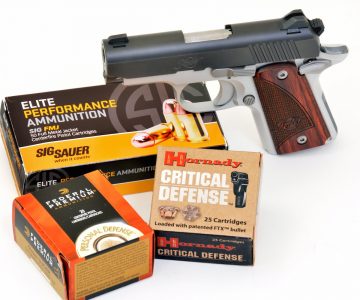
The Micro 9 was tested with Sig Sauer 115 gr. Elite Performance FMJ, Hornady Critical Defense 115 gr. FTX, and Federal Premium 124 gr. Hydra-Shok JHP.
[/one_half]
[one_half_last]
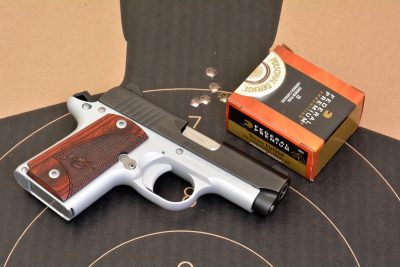
A set was fired at the top of the 7-ring with five rounds grouping at 1.1 inches using Federal Premium Hydra-Shok. This proved to be the best group shot with the Micro 9.
[/one_half_last]
To test the advantages of this Mustang-sized (actually about 10 percent larger according to Kimber), recoil-operated, locked-breech design 9mm pocket pistol, I selected a mix of traditional 9mm full metal jacketed ammo using Sig Sauer 115 gr. FMJ, and two personal defense loads, Federal Premium 124 gr. Hydra-Shok JHP, and Hornady Critical Defense 115 gr. FTX. The Hornady round, in particular, is designed for smaller (compact, subcompact) handguns but to deliver maximum performance with less recoil than other tactical loads. It is also available in a 100 gr. FTX Lite load. Given the size of the Micro 9, I opted out of raising the stakes with 147 gr. rounds, and kept the test in the 115 to 124 gr. range. Kimber also recommends minimal use of +P and cautions against any +P+ rounds in the Micro 9.
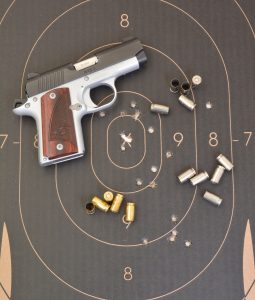
Using three different types of 9mm ammo, the Micro 9 delivered tight 5-shot groups from 21 feet. With one shot pulled right, landing in the 8 ring at about 3 o’clock, average groups were 2-inches or less for the pistol. Shots in the low 9 and 8 ring at 4 o’clock were fired with Sig Sauer FMJ rounds at that POA.
Fired from a combat distance of 21 feet (7 yards), the Micro 9’s 3.15-inch barrel sent the standard 115 gr. FMJ rounds downrange at an average velocity of 1,123 fps. The 115 gr. Hornady FTX were a bit slower clocking an average of 1,097 fps while the heavier 124 gr. Federal Premium cleared the chronograph at 1,008 fps.
Recoil for a pistol of this size and weight is usually pretty heavy, but the Micro 9 surprises, with less felt recoil than the Kimber Solo. It’s no .380, but compared to other small 9mms it is more manageable. I’m not impressed with the standard sights; not their design but rather the lack of at least a white dot on the front for faster target acquisition, but they are interchangeable, so nothing that a little extra out of pocket can’t fix. As for the rest of the Micro 9, it is an impressive piece of work.
With rounds fired offhand using a two-handed hold and Weaver stance, the best overall groups with the Sig Sauer 115 gr. FMJ measured 2.0 inches, Hornady FTX grouped tighter with a best five at 1.85 inches, and with a little extra practice the heavy-hitting Federal Premium rounds improved from a rather disappointing 3.75 inches across the center body mass of the target to a tight 1.26 inches. At point of aim, my groups, save for the first try with the Hydra-Shok, were never short of at least two to three shots under 0.50 inches, so this little 9mm can do its job if you do yours.
Final Evaluation
I have carried .380 semi-autos for over 25 years, either as a backup or primary sidearm for concealed carry, everything from a Walther PPK/S to a Ruger LCP Custom, and the question I have to answer for myself (and thus for many of you) is that given an almost equal size and weight, would I trade off my .380s for this new 9mm? After looking at the shooting results, effective stopping power of the 9mm over the .380, comparative recoil with this particular pistol, and the fact that I don’t have to change holsters or carry techniques, the answer is a resounding yes.
[1] All ballistic data from the Ammo Encyclopedia by Michael Bussard, published by Blue Book Publications.
To learn more, visit https://www.kimberamerica.com/pistols/micro-9.
To purchase on GunsAmerica.com, click this link: https://www.gunsamerica.com/Search.aspx?T=Kimber%20%22Micro%209%22.